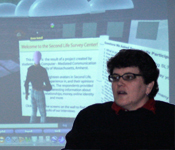 For our second Emerging Technology and Pie event of the semester Florence Sullivan, professor in the School of Education, joined us to talk about her explorations of virtual worlds. Popularized by Second Life, virtual worlds are three-dimensional(3D) spaces in which people can communicate, explore environments, and construct their own virtual objects and spaces. When you connect to a service like Second Life, you are entering a 3D virtual world where you are represented by an avatar, a customized 3D representation of yourself. You control your avatar and move around the virtual world, interacting with objects or chatting with other participants who are connected to the world.
For our second Emerging Technology and Pie event of the semester Florence Sullivan, professor in the School of Education, joined us to talk about her explorations of virtual worlds. Popularized by Second Life, virtual worlds are three-dimensional(3D) spaces in which people can communicate, explore environments, and construct their own virtual objects and spaces. When you connect to a service like Second Life, you are entering a 3D virtual world where you are represented by an avatar, a customized 3D representation of yourself. You control your avatar and move around the virtual world, interacting with objects or chatting with other participants who are connected to the world.
Professor Sullivan has been using Virtual Worlds for several years as part of her research and for School of Education graduate courses such as “Computer Mediated Communications” and “Educational Media Theory.” Her students began their initial explorations of Second Life in the context of their media theory studies. Sullivan described her first experiences using Second Life with graduate students as an experiment that didn’t quite take off. Some students simply felt Second Life was boring; for others, it seemed to promise a video game one would get to use for class, a promise Second Life didn’t deliver on.
Based on this initial experiment, Professor Sullivan worked with her students to revise the syllabus and better integrate Second Life into the course. For one project, students created a “sculpture garden” of interactive objects within Second Life that depicted changes in the history of media. Another group of students constructed a virtual meeting space for their class: a small virtual room decorated with artifacts related to utopian and dystopian futures (a theme from the course). Other students conducted a survey of Second Life users about why they use virtual worlds and their habits, and presented their findings as an object in Second Life.
A variety of interesting behaviors and practices emerged from these explorations. Professor Sullivan was interested to see how students would interact with people in Second Life compared to how they interact in-person, even in places where the environment operates under a different set of constraints (such as being able to send messages to anyone logged into Second Life.) Students would situate their avatars around a speaker they would encounter even through Second Life allows for one to chat back and forth with people who don’t have to be “physically” near by. She felt that this form of presence was a significant and important component of virtual worlds that is not provided by other communication tools. Some of her students unfortunately encountered malicious behavior from other users when exploring the open areas in Second Life; though there is nothing that can be done to permanently harm a user in Second Life, there are things that can be done where the only escape is to exit Second Life. Sullivan discussed the issues of emotional safety in these environments and how a UMass Amherst location in Second Life would be particularly valuable for providing a safe environment.
Professor Sullivan concluded her talk by stressing the importance of having a goal for using Second Life as part of any class. She sees Second Life as having limited value as a means of simply delivering course content, but that it offers other applications for interacting with people as well as exploring and constructing spaces. Many school have constructed spaces in Second Life for training and simulation activities.
Stay tuned to TeachOIT to hear more about Second Life at UMass Amherst and our plans for next semester with virtual worlds.
More about Second Life
7 Things You Should Know about Virtual Worlds